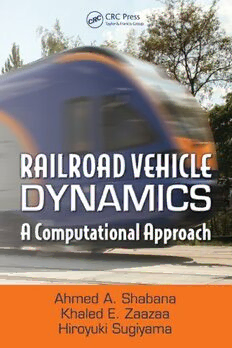Download Railroad vehicle dynamics: a computational approach PDF Free - Full Version
Download Railroad vehicle dynamics: a computational approach by Ahmed A. Shabana, Khaled E. Zaazaa, Hiroyuki Sugiyama in PDF format completely FREE. No registration required, no payment needed. Get instant access to this valuable resource on PDFdrive.to!
About Railroad vehicle dynamics: a computational approach
The methods of computational mechanics have been used extensively in modeling many physical systems. The use of multibody-system techniques, in particular, has been applied successfully in the study of various, fundamentally different applications. Railroad Vehicle Dynamics: A Computational Approach presents a computational multibody-system approach that can be used to develop complex models of railroad vehicle systems. The book examines several computational multibody-system formulations and discusses their computer implementation. The computational algorithms based on these general formulations can be used to develop general- and special-purpose railroad vehicle computer programs for use in the analysis of railroad vehicle systems, including the study of derailment and accident scenarios, design issues, and performance evaluation. The authors focus on the development of fully nonlinear formulations, supported by an explanation of the limitations of the linearized formulations that are frequently used in the analysis of railroad vehicle systems. The chapters of the book are organized to guide readers from basic concepts and definitions through a final understanding of the utility of fully nonlinear multibody- system formulations in the analysis of railroad vehicle systems. Railroad Vehicle Dynamics: A Computational Approach is a valuable reference for researchers and practicing engineers who commonly use general-purpose, multibody-system computer programs in the analysis, design, and performance evaluation of railroad vehicle systems.
Detailed Information
| Author: | Ahmed A. Shabana, Khaled E. Zaazaa, Hiroyuki Sugiyama |
|---|---|
| Publication Year: | 2008 |
| ISBN: | 1420045814 |
| Pages: | 362 |
| Language: | English |
| File Size: | 7.238 |
| Format: | |
| Price: | FREE |
Safe & Secure Download - No registration required
Why Choose PDFdrive for Your Free Railroad vehicle dynamics: a computational approach Download?
- 100% Free: No hidden fees or subscriptions required for one book every day.
- No Registration: Immediate access is available without creating accounts for one book every day.
- Safe and Secure: Clean downloads without malware or viruses
- Multiple Formats: PDF, MOBI, Mpub,... optimized for all devices
- Educational Resource: Supporting knowledge sharing and learning
Frequently Asked Questions
Is it really free to download Railroad vehicle dynamics: a computational approach PDF?
Yes, on https://PDFdrive.to you can download Railroad vehicle dynamics: a computational approach by Ahmed A. Shabana, Khaled E. Zaazaa, Hiroyuki Sugiyama completely free. We don't require any payment, subscription, or registration to access this PDF file. For 3 books every day.
How can I read Railroad vehicle dynamics: a computational approach on my mobile device?
After downloading Railroad vehicle dynamics: a computational approach PDF, you can open it with any PDF reader app on your phone or tablet. We recommend using Adobe Acrobat Reader, Apple Books, or Google Play Books for the best reading experience.
Is this the full version of Railroad vehicle dynamics: a computational approach?
Yes, this is the complete PDF version of Railroad vehicle dynamics: a computational approach by Ahmed A. Shabana, Khaled E. Zaazaa, Hiroyuki Sugiyama. You will be able to read the entire content as in the printed version without missing any pages.
Is it legal to download Railroad vehicle dynamics: a computational approach PDF for free?
https://PDFdrive.to provides links to free educational resources available online. We do not store any files on our servers. Please be aware of copyright laws in your country before downloading.
The materials shared are intended for research, educational, and personal use in accordance with fair use principles.

